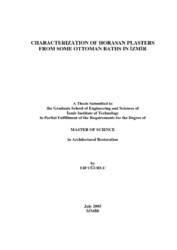Please use this identifier to cite or link to this item:
https://hdl.handle.net/11147/3224Full metadata record
| DC Field | Value | Language |
|---|---|---|
| dc.contributor.advisor | Böke, Hasan | en |
| dc.contributor.author | Uğurlu, Elif | - |
| dc.date.accessioned | 2014-07-22T13:51:07Z | - |
| dc.date.available | 2014-07-22T13:51:07Z | - |
| dc.date.issued | 2005 | en |
| dc.identifier.uri | http://hdl.handle.net/11147/3224 | - |
| dc.description | Thesis (Master)--Izmir Institute Of Technology, Architectural Restoration, Izmir, 2005 | en |
| dc.description | Includes bibliographical references (leaves: 89-96) | en |
| dc.description | Text in English; Abstract: Turkish and English | en |
| dc.description | xiii, 110 leaves | en |
| dc.description.abstract | Mortars and plasters of many Roman, Byzantine, Seljuk and Ottoman period buildings were produced by using lime as binder and crushed bricks or tiles as aggregates. These mortars and plasters are called as .horasan. mortars and plasters in Turkey. Horasan mortars and plasters have been widely used as waterproof materials in aqueducts, bridges, cisterns and baths due to their hydraulic properties and high mechanical strengths.In this study, characteristics of horasan plasters used in some Ottoman bath buildings in Urla and Seferihisar in zmir were investigated by using XRD, SEM-EDX, AFM and chemical analyses.Physical, chemical and microstructural properties of plasters do not differ according to spaces, levels and layers generally. All of the plasters are porous and low dense. Multi layered horasan plaster application with the less porous finishing layers provide a waterproof surface to lower levels. Lime/aggregate ratios of horasan plasters are in the range of 1/2 and 3/2. Horasan plasters are hydraulic owing to the presence of pozzolanic brick aggregates. Crushed and powdered brick aggregates are good pozzolans since they were produced from raw materials containing high amounts of clay and they were fired at low temperatures.On the other hand, bricks used in the domes of the baths were manufactured by using raw materials containing fewer amounts of clay minerals than those of aggregates.Due to the less amounts of clays in their compositions, they are not pozzolanic although fired at low temperatures. This result revealed that crushed brick aggregates were manufactured intentionally to use in horasan plasters. | en |
| dc.language.iso | en | en_US |
| dc.publisher | Izmir Institute of Technology | en |
| dc.rights | info:eu-repo/semantics/openAccess | en_US |
| dc.subject | Ottoman bath | en |
| dc.subject | Horasan plaster | en |
| dc.subject.lcc | NA7010 .U27 2005 | en |
| dc.subject.lcsh | Baths,Turkish--İzmir | en |
| dc.subject.lcsh | Plaster | en |
| dc.subject.lcsh | Mortar--Additives | en |
| dc.title | Characterization of Horasan plasters from some Ottoman baths in Izmir | en_US |
| dc.type | Master Thesis | en_US |
| dc.institutionauthor | Uğurlu, Elif | - |
| dc.department | Thesis (Master)--İzmir Institute of Technology, Conservation and Restoration of Cultural Heritage | en_US |
| dc.relation.publicationcategory | Tez | en_US |
| item.languageiso639-1 | en | - |
| item.fulltext | With Fulltext | - |
| item.openairecristype | http://purl.org/coar/resource_type/c_18cf | - |
| item.openairetype | Master Thesis | - |
| item.grantfulltext | open | - |
| item.cerifentitytype | Publications | - |
| crisitem.author.dept | 02.01. Department of Conservation and Restoration of Cultural Heritage | - |
| Appears in Collections: | Master Degree / Yüksek Lisans Tezleri | |
Files in This Item:
| File | Description | Size | Format | |
|---|---|---|---|---|
| T000342.pdf | MasterThesis | 19.63 MB | Adobe PDF |  View/Open |
CORE Recommender
Page view(s)
226
checked on Jul 22, 2024
Download(s)
174
checked on Jul 22, 2024
Google ScholarTM
Check
Items in GCRIS Repository are protected by copyright, with all rights reserved, unless otherwise indicated.